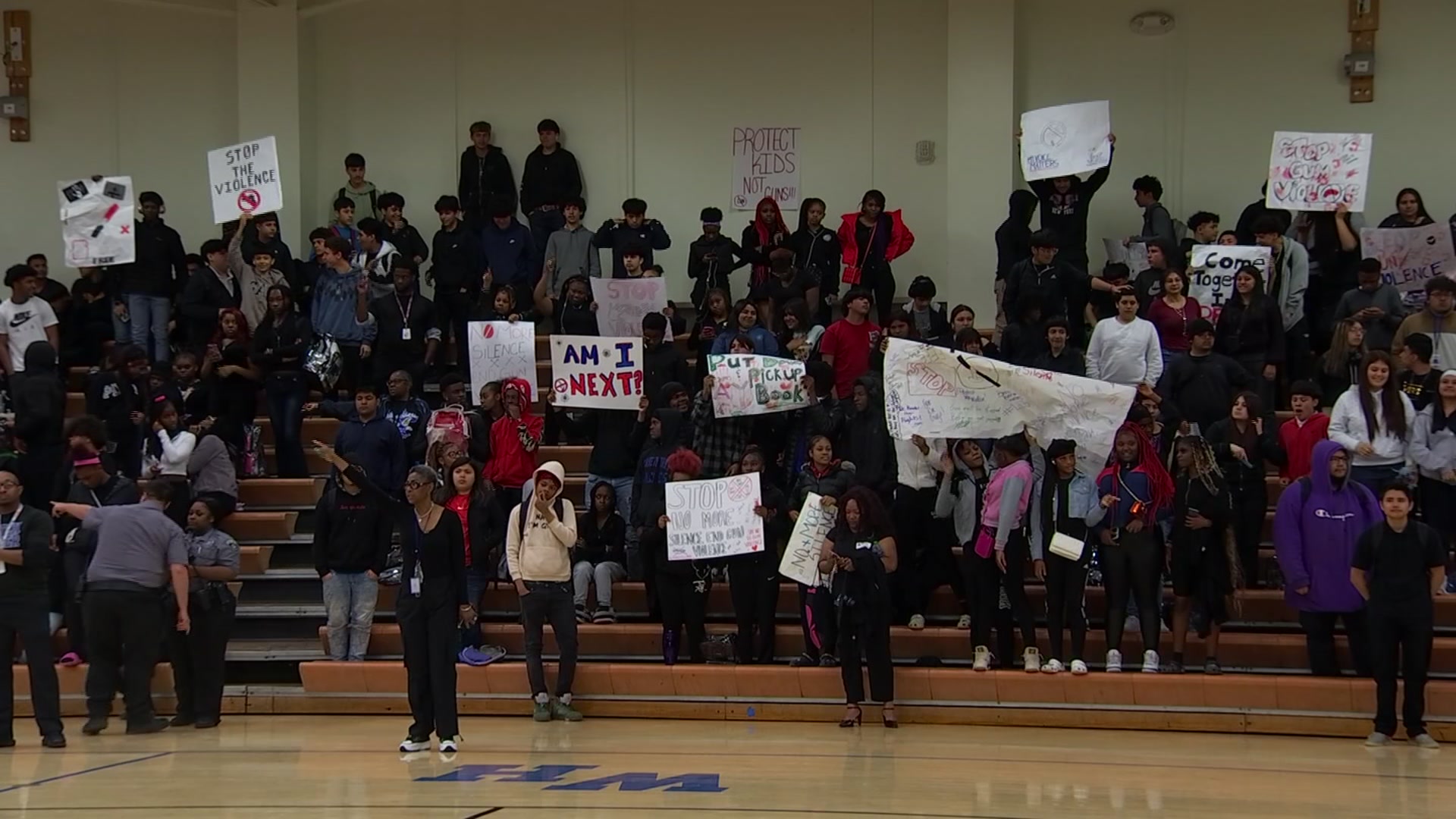Strip away the enormity of rebuilding Interstate 45 and the promise of speedier trips along downtown Houston freeways, and two questions about the once-in-a-generation project remain:
How many negative effects are acceptable in one neighborhood for other people's faster commutes?
And, how far should transportation officials go to reduce those impacts, to secure support and not vocal opposition?
"This is the defining project in the city of Houston for the next 20 years," said Michael Skelly, a local businessman and organizer of the Make I-45 Better Coalition. "Doing it properly means minimizing impacts and, where there are impacts, mitigating them properly."
The Houston Chronicle reports impacts expected from the widening of I-45 from downtown north to the Sam Houston Tollway -- including a $3 billion remake of the downtown freeway system that buries a portion of the freeways and tears down the Pierce Elevated -- run the gamut of environmental and social ills: air quality and flooding concerns for schools, day cares and low-income communities; removal of public housing developments in a city already hurting for affordable homes; concrete pillars and ramps rising above pristine park space along area bayous; uprooting 300 businesses employing 24,000 people and 1,400 homes.
"What concerns us as a group is inequity," said Oni Blair, executive director of LINK Houston, a local transportation advocacy group. "They will feel losses, not gains."
Texas Department of Transportation officials say they are balancing those concerns with a need to rebuild a freeway beyond its useful life, in a way that officials believe prepares for how Houston will move more than a decade from now.
Local
The latest news from around North Texas.
"We are working real hard to make this work," said Quincy Allen, district engineer for the six-county Houston area. "Everything we've heard, we've said `let's see if we can make this work."'
Not every problem, however, has a solution as TxDOT awaits federal approvals, possibly by the end of this year. The total cost of the project could climb above $7 billion. Construction on the segments where I-45, Interstate 69 and Texas 288 intersect could start as early as 2021.
That means the opportunity to tweak a project 18 years in the making is closing, with a lot of concerns remaining despite years of unprecedented public engagement between transportation officials and neighborhood and advocacy groups.
"We have heard more noes than yesses," Rebecca Reyna, executive director of the Greater Northside Management District, said of attempts to alter the project through talking to TxDOT.
If there is hope, TxDOT and advocates for changes said, it is that everyone keep talking.
"We can't do everything, but we will consider anything," TxDOT spokeswoman Raquelle Lewis said.
Opponents said they are committed to making sure whatever is built does not tear more inner-city neighborhoods apart.
"It is not fair for us to put up with the traffic impacts to serve people who do not live in the city," said Christel Bastida, a Northside resident active with the Greater Houston Coalition for Justice. "You do not get to step on them just because it is convenient for everyone else."
The project aims to add two managed lanes in each direction to I-45 north of the central business district as part of a total freeway rebuild from Interstate 69 to the Sam Houston Tollway near Bush Intercontinental Airport.
Proponents of the freeway plan argue Houston is choking on congestion along the I-45 corridor and efforts to lure people out of their cars so far have not changed things. Adding managed lanes -- which benefit buses and carpoolers -- helps manage traffic without adding general use lanes.
"Very little capacity is added," Allen said, explaining that the premise is using the limited right of way TxDOT has more efficiently.
In an analysis of the project, TxDOT and HNTB -- the engineering firm hired to oversee design of the new freeway -- estimated the new freeway would increase average speeds at peak commuting times by 24 mph, an unprecedented increase.
"We believe our project is a net benefit to air quality by reducing congestion and having people sit in traffic," Allen said.
Air quality and neighborhood advocates for the communities where the wider freeway will run have called that logic into question.
Anytime lanes are added, drivers gladly fill them up until they are full, the thinking goes.
"Continuing to expand highways as a way to address congestion . only fuels our dependence on single-passenger vehicles," said Bakeyah Nelson, executive director of Air Alliance Houston.
In a recent assessment, Air Alliance Houston found at nine nearby school campuses that vehicle travel near the school is seven times the average for Houston Independent School District campuses. Those sites already suffer some of the worst air quality in the region, likely because of their proximity to the highway.
Bruce Elementary near I-69 and I-10 -- already with some of the highest rates of children with asthma -- would experience a 175% increase in benzene emissions, researchers concluded.
"Discontinue the legacy of treating communities of color and low income as collateral damage," Nelson said.
Allen said TxDOT hopes to plant as much vegetation as practical, aimed at soaking up carbon emissions. The Houston district is the leader statewide in using trees, bushes and shrubs to line freeways with the goal of reducing visual impacts and keeping pollutants from spreading in the wind.
Allen this month said that, if they can, officials are considering using air quality money to buy Houston Independent School District electric buses to remove their emissions in a nod to reducing overall air effects at the school.
They also are talking about better sealing school windows to reduce pollution coming into the buildings.
The remedies, however, do not address the pollution as much as they take steps to remove people from it, critics said.
"It is not enough of an answer to say how we keep people safe inside," Houston District H Councilwoman Karla Cisneros said. "We don't want children to only be safe inside a building."
The freeway rebuild offers a rare chance to remake part of downtown Houston, too. As a result of the redesign, TxDOT will eliminate the elevated segment of I-45 that crosses downtown, known as the Pierce Elevated, while keeping local access ramps to Allen Parkway and other streets on the west side of the central business district.
Burying I-45 and I-69 along the side of the George R. Brown Convention also will allow designers to cap the freeways with a public space, akin to another Discovery Green. In many respects, what officials are promising is a much better freeway than the one there now, proponents said.
"We need to reconnect neighborhoods where a project 50 years ago kind of cut them apart," said Bob Eury, president of the Houston Downtown Management District. "We think there is an opportunity to create connected open parks and public spaces that has a real benefit for the community."
Those benefits, however, come with concessions. For the promise of eliminating the Pierce Elevated or a new downtown park, the project also alters open land along White Oak bayou just north of downtown, overshadowing it with ten lanes of new interchange ramps. Businesses and homes will be lost to a wider freeway, including the Clayton Homes complex operated by the Houston Housing Authority near I-69 and Buffalo Bayou and Kelly Village about a mile north, on the other side of I-10.
Independence Heights, the first city in Texas incorporated by black residents, has lost land to Loop 610 and I-45 over the past 40 years would lose even more homes and businesses.
"Our historical assets have been trampled over and over again," said Tanya Debose, executive director of the Independent Heights Redevelopment Council.
Community leaders also worry more freeway lanes could further worsen flooding in the area. Along with burying the freeway along the east side of the central business district, remaking I-45 north to the tollway requires a major rethinking of drainage along White Oak Bayou and Little White Oak Bayou, which flows through the I-45 interchange with Loop 610.
Officials counter that they have gone to unprecedented lengths to adjust drainage plans along the way.
"We have done more drainage on this project than I any I have ever been on," said Allen, a nearly 35-year TxDOT veteran.
Massive pump stations, with redundancies built into them, as well as emergency systems in the event of power loss, will keep the freeways open, Allen said. The depressed section of I-69 southwest of Spur 527 turned into a lake during Tropical Storm Alison in 2001 when it still was under construction. Since, the massive pump stations that clear water from it have kept it mostly open through every major storm, including Harvey.
Along the way, Allen said officials have worked up and down the freeway to listen to concerns and redraw designs over and over. The plan reflects many of those changes and is likely to reflect many more, he said. Engineers are looking at crossings for pedestrians and bicyclists. TxDOT is negotiating to purchase a piece of land somewhere near downtown, with plans to let Clayton Homes and Kelly Village stay in their current places until a new Houston Housing Authority property is finished.
There has been talk of a land bank or some sort of trust to relocate Independence Heights homes in the community, without homeowners taking a hit in terms of property taxes. TxDOT engineers have added width on bridges across the freeway for a buffer for bicyclists and pedestrians.
Allen said he is hopeful TxDOT can design it to satisfy every concern within their power.
"We have gone to everyone with a concern and said `let's see what we can do,"' Allen said. "There's just. there are some things that are just difficult."



